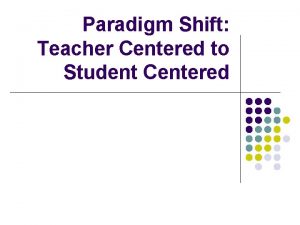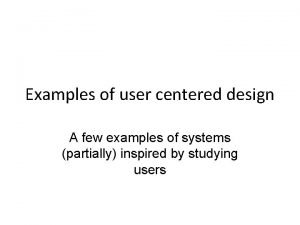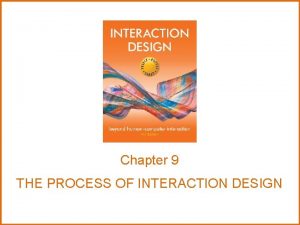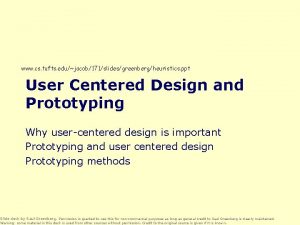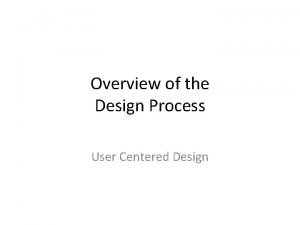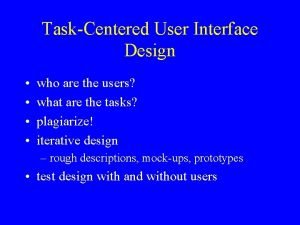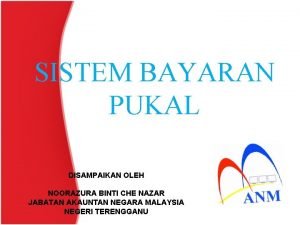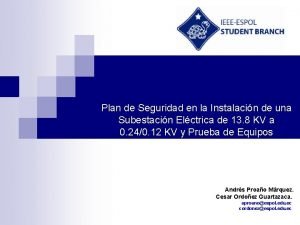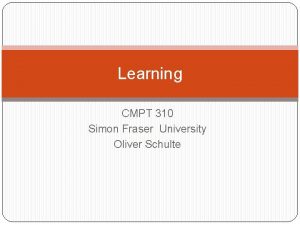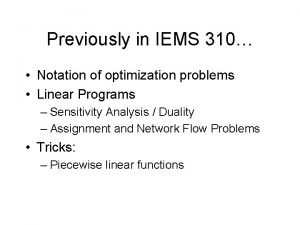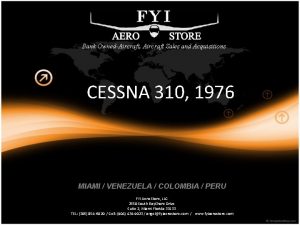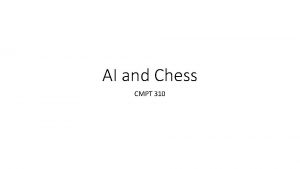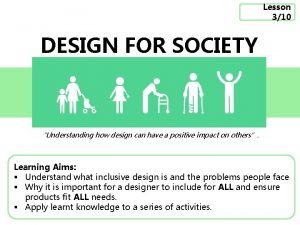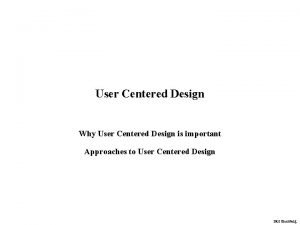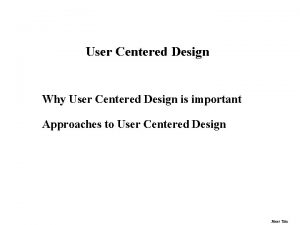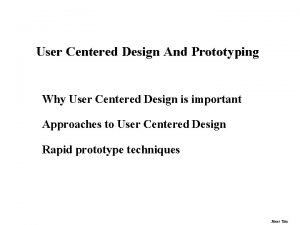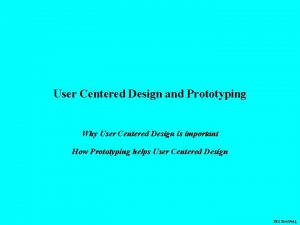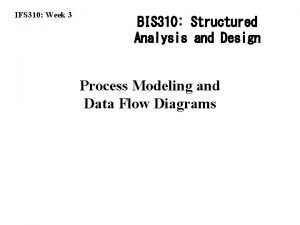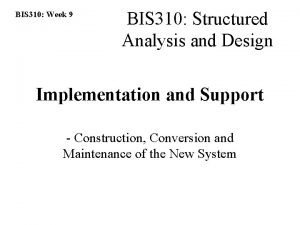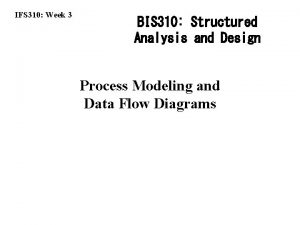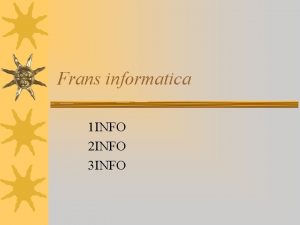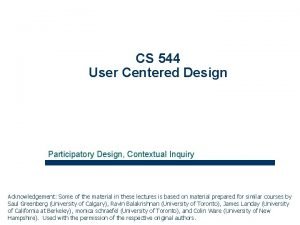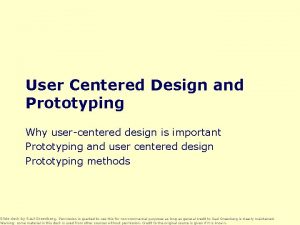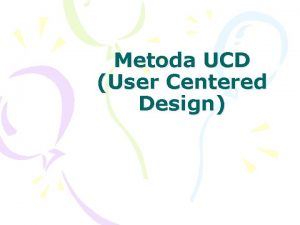INFO 310 User Centered Design User centered design




















- Slides: 20

INFO 310 User Centered Design

User centered design (Allen, 1996) n n n Identify a user population Investigate the information needs of the user group Discover the tasks that users accomplish as they meet these information needs Investigate the resources that users require to complete these tasks Summarize the preceding steps in user models Consider each design decision in the light of resource augmentation and enabling

Identify a user population n The first step in user-centered design is to find a user population. Sometimes user identification is dictated by the mission of the organization where the designer works. In other cases, users may be selected by the designer. The identification of the user population is such an obvious step that it is sometimes omitted. This omission results in systems that are not particularly usable for any set of users.

Investigate the information needs of the user group n n Information needs can be investigated using a wide range of research methods. The key element of this step is to talk to users and find out what kinds of information they need to resolve the problems they encounter. No information system can meet all of the information needs of a user group. Once the full range of information needs has been identified, system designers must select those that their information system will be designed to meet.

Discover the tasks that users accomplish as they meet these information needs n n Talk to users and observe them as they work on meeting their information needs. Identify the tasks that users employ as they meet their information needs and how they accomplish these tasks. Try to distinguish between the tasks that are essential and those that are optional. The result will be one or more task models for each information need.

Investigate the resources that users require to complete these tasks n n n Each task completed by a user who is meeting an information need requires a variety of resources: background knowledge, procedural knowledge, and abilities. List the resources required for each task and identify the level of the resources required. It is important to note the levels of these resources that users possess.

Summarize the preceding steps in user models n n For each distinct user group to be served by the information system, there will be a number of information needs that the system is designed to meet. For each of these information needs, there will be a number of tasks that must be accomplished. For each of the tasks, there will be a list of resources that are necessary. Integrating these elements together results in a user model that can be used to guide design decisions or that can be implemented as part of the information system to direct how the system will respond to users.

Break out session – 10 minutes Summarize the preceding steps in user models for the recruitment arm of the American Red Cross

Consider each design decision in the light of resource augmentation and enabling n n The goal of system design is to allow users to complete the tasks that will meet their information needs. With this in mind, system features that will augment the resources of users when necessary will enable them to complete the tasks. Some of these features will be required by all users, while others will be required by only a portion of the user group. Experimental research can be used to select system features that should be implemented as user-selectable options.

Value Sensitive Design (Friedman et al, forthcoming) “. . . a theoretically grounded approach to the design of technology that accounts for human values in a principled and comprehensive manner throughout the design process. ”

What are “values” and can we incorporate them in design? the economic worth of an object n what a person or group of people consider important in life n morality, ethics n facts vs. values n

Related Approaches computer ethics n social informatics n computer supported cooperative work (CSCW) n participatory design n

Tripartite Methodology conceptual n empirical n technical n

Conceptual Investigations What values are implicated? n trust n anonymity n security n privacy n etc. . .

Empirical Investigations What can we infer by observing, measuring and documenting the activities of our user group? n are values prioritized over usability? n in interactive contexts what values or considerations are most important?

Technical Investigations n n some technological solutions are more suitable for certain activities they may support certain values and make others more difficult to realize ¨ video - based collaborative work spaces ¨ video surveillance ! ¨ bio - identification systems n n fingerprinting optical scanning

Case Studies Cookies and Informed Consent in Web Browsers n Office Window of the Future n Urban. Sim n

Using Value Sensitive Design n n begin with a value, technology or specific context of use identify direct and indirect stakeholders identify benefits and harms for each stakeholder group map benefits and harms onto corresponding values conduct a conceptual investigation of key values identify potential value conflicts integrate value considerations in to the organizational structure consider human values with ethical import interview stakeholders conduct technical investigations

Break out – 15 minutes n n n Consider user centered design and value sensitive design side by side Your team’s job is to analyze the American Red Cross’ website by brainstorming on who the stakeholders (both direct and indirect) are, their information needs and the values supported or undermined through the site as it is now Make recommendations to enhance the website that address HIB and value sensitive design.

Synthesis n n n The goal of user centered system design is to provide users the means to complete tasks that will meet their information needs. The value sensitive design approach strives to incorporate universal human values into the design of information and computational systems. This in turn will provide the user with a means to conduct their work or meet their information needs in an arena that supports universal values.
 Paradigm shift teacher-centered to student-centered
Paradigm shift teacher-centered to student-centered User-centered design examples
User-centered design examples What are the three principles of user-centered design?
What are the three principles of user-centered design? User centered design ppt
User centered design ppt User centered design process steps
User centered design process steps Task centered user interface design
Task centered user interface design Kew 310
Kew 310 Tabla 310-15
Tabla 310-15 310 huey p long
310 huey p long Nuclear compaction test
Nuclear compaction test 310-15(b)(2)(a)
310-15(b)(2)(a) Cmpt310
Cmpt310 Split duplex receptacle symbol
Split duplex receptacle symbol Marbled crested lizard
Marbled crested lizard 3-5/310
3-5/310 Iems 310
Iems 310 Bank repossessed aircraft
Bank repossessed aircraft Ai 310
Ai 310 Isa 310
Isa 310 Lesson 310
Lesson 310 Hkn review
Hkn review
